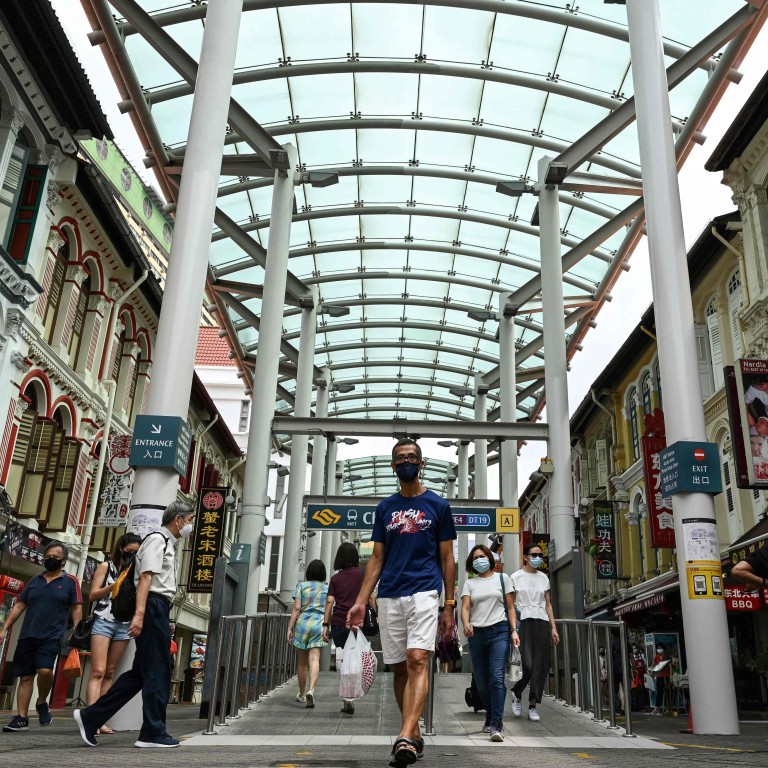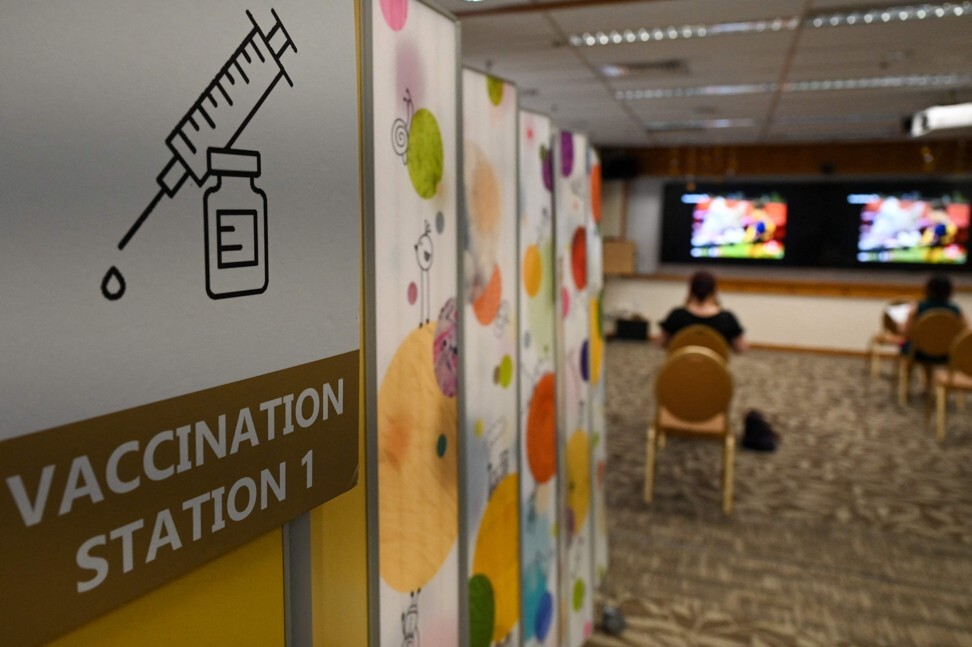
In Singapore, ‘living with Covid-19’ feels like walking a tightrope of uncertainty, residents say
- The launch of a travel corridor with Germany and Brunei on September 8 was meant to mark a major milestone in vaccination efforts
- But rising cases have sparked words of caution from authorities, leaving residents questioning if the country is on the cusp of reopening or a return to pandemic-fighting mode
From Wednesday, with 88 per cent of the country’s eligible population now fully inoculated, fully-vaccinated Singapore residents will have a green light to travel to Germany and Brunei and return without serving quarantine, after almost two years of being told remain on an island slightly smaller than New York City.
After reporting 1,325 domestic cases in the past week, up from 723 the week before, Singapore on Monday announced a ban on gatherings and interactions at workplaces, effective Wednesday, and urged people to limit social gatherings to once a day.
Singapore vows quick action after Covid-19 cases nearly double
On Monday, remarks by finance minister Lawrence Wong sparked questions on social media on whether the goal posts for reopening domestically had once again shifted or if a reversal of the endemic policy was imminent.
Wong said while authorities would try to slow down transmissions without tightening restrictions, he would not rule out a return to the state of “heightened alert” involving bans on dining out – or, worse, to the so-called circuit breaker last year, during which people had to remain at home except for grocery runs or outdoor exercise.
The government’s cautious stance has once again cast the spotlight on the difficulties that Asian economies – which initially closed their borders and relied on tough restrictions – are facing in their transition to living with Covid-19, as it becomes clearer that vaccinations alone cannot fend off the more virulent Delta variant.

04:47
Hong Kong should follow Singapore’s lead and drop ‘zero case’ approach to Covid-19
Dr Jeremy Lim from the Saw Swee Hock School of Public Health at the National University of Singapore (NUS) said Wong’s words of caution were based on epidemiological models, and the theoretical concerns were understandable. According to modelling by Alex Cook, the vice dean of research at the same school, Singapore could hit 1,000 cases a day by the end of September if infections went on at the current rate.
Wong’s rationale was that a very high caseload would “translate to a sizeable number of ICU cases and eventually, fatalities”. There are 643 Covid-19 patients currently hospitalised in Singapore, six of whom are in the intensive care unit.
Still, Lim said Monday’s warning was “a bitter pill to swallow for the vast majority of Singaporeans who have dutifully followed the government’s directions, and were expecting September to herald the full start of a Covid-resilient era”.
Singapore will deliver Covid-19 booster shots to better guard against Delta variant
Added Cook: “On one hand, Singapore has been saying it’s ready to move into the next phase of the pandemic, which must involve some degree of letting go and accepting cases will rise. Yet when cases rise, there is a volte-face and a tightening of restrictions.
“If Singapore is never willing to let cases rise, it will be stuck fighting the pandemic for years.”
Delta blues
Dr Paul Tambyah, president of the Asia Pacific Society of Clinical Microbiology and Infection, said the city state’s reopening plan was being closely watched by its neighbours in Asia, who would be on the lookout for a rebound in cases or severe cases as Singapore reopened.
While Singapore’s virus numbers are still far from the caseloads that its immediate neighbours are experiencing, it has reported about 200 new cases a day recently. Kenneth Mak, the health ministry’s director of medical services, said on Friday that this was not “unexpected” and the health care system was not “overly burdened” given current vaccination rates and a relatively steady rate of ICU admissions.
But finance minister Wong on Monday revealed he was uncomfortable with the reproduction rate of the virus being higher than 1, as “if we continue on this trajectory of infection, it means we could have 1,000 cases in two weeks, or possibly 2,000 cases in a month”.
“We know from the experience of other countries that when cases rise so sharply, there will be many more ICU cases and also people succumbing to the virus,” he said.
The reproduction rate of the Delta strain, known as R0, has been reported as between 5 and 8, meaning that one person typically transmits the virus to between five and eight other people. Local media reported on Tuesday that Singapore’s R0 was at 1.45 with existing management measures in place.
Leo Yee Sin, the executive director of the National Centre for Infectious Diseases, added to the warnings from authorities when she said, in an interview published in The Straits Times on Tuesday, that vaccinations alone were not enough. Singapore still needed to be cautious, she said, adding that Covid-19 could not be seen as the common flu.
Dr Dale Fisher, who chairs the World Health Organization’s Global Outbreak Alert and Response Network, said Singapore’s exit strategy was appropriately “cautionary and stepwise”. He added that the recent spike in cases provided a gauge on the amount of hospitalisations, which led to authorities tempering social activities to slow the rate of increase.
The severe cases the city state has been having are overwhelmingly among the minority of the population who declined to be vaccinated
“If extreme numbers of cases translate into large numbers requiring hospitalisation, then it will take the reintroduction of harsh measures to reverse. A more gradual exit strategy allows us to monitor and mitigate as we go,” Fisher said.
Still, other analysts speaking to This Week in Asia said Singapore could afford to be bolder.
“Singapore’s epidemic situation is still extremely favourable,” said NUS vice dean Cook, citing the 55 deaths and six in the ICU as of Monday. “While we would expect this number to rise in the days ahead, the severe cases the city state has been having are overwhelmingly among the minority of the population who declined to be vaccinated.”
Lim from NUS, using the Chinese idiom about crossing a river by feeling one’s way across using stones, said Singapore should wet its feet and step forward boldly. “Singapore should also not be excessively risk averse and be paralysed by ‘doom and gloom’ modelling. It’s OK to feel the stones and decide later to walk back and take a different path,” he said.
Tricky messaging
Dr David Allen, a senior consultant of infectious diseases at the NUS Yong Loo Lin School of Medicine, said people were getting more informed and familiar with the virus, and, combined with pandemic fatigue, were more likely to be annoyed by restrictions than by the number of cases.
He said the government had been consistent in saying that the virus situation was fluid, but residents only heard the part of the message that matched their wishes.
This is a rare situation for Singapore, where the government has earned praise for its sharp messaging and its successful vaccination campaign.
But explaining endemicity and how a country would live with Covid-19 was not as straightforward as encouraging people to get vaccinated, reasoned Claire Hooker, a senior lecturer in health and medical humanities at the University of Sydney.
“Telling people to live with Covid-19 is more complicated partly because we are back to a state of uncertainty and arrangements are going to be made on the fly,” she said. “You can’t give people a simple message that is certain.”
At times, Hooker said, this would mean reimposing restrictions people thought they had been freed from, and it would make messaging sound “contradictory or confusing or sometimes, just disappointing to people”.
As Singaporeans express disappointment at the situation, Hooker said the government should not shy away from listening to the thoughts of residents. “The first thing is acknowledging it, saying ‘I know everyone’s disappointed. I know we might sound like we are contradicting ourselves, maybe you feel betrayed that we were offering you a false hope’,” she said.
Then, Hooker said, the authorities could share specific indicators they were looking out for when toggling restrictions, but at the same time be upfront about communicating the level of uncertainty. “A big driver of outrage is when people feel that they don’t have any control and are not being heard.”
Said Cook from NUS: “We still report the daily case numbers on the front pages, but the real numbers to worry about are how many are falling badly sick, not how many mild cases are found through mass contact tracing efforts.”
He said that Singapore needed a clear idea of what the endemic state would look like, such as recording large numbers of domestic cases each day as long as they were not severe cases. Authorities then had to “sensitise” the population to that image, he said.
Fisher of the WHO, who is also a professor at the NUS Yong Loo Lin School of Medicine, said it was important that Singapore and countries undergoing a transition to an endemic state remembered that the strategy was to prevent death and severe diseases. Case numbers, he said, were not nearly as relevant as during the pre-vaccination period.
“There is a lot of apprehension as we move forward step by step, having had such good control through the pandemic, to now change tack and let the case numbers drift up,” he said.




